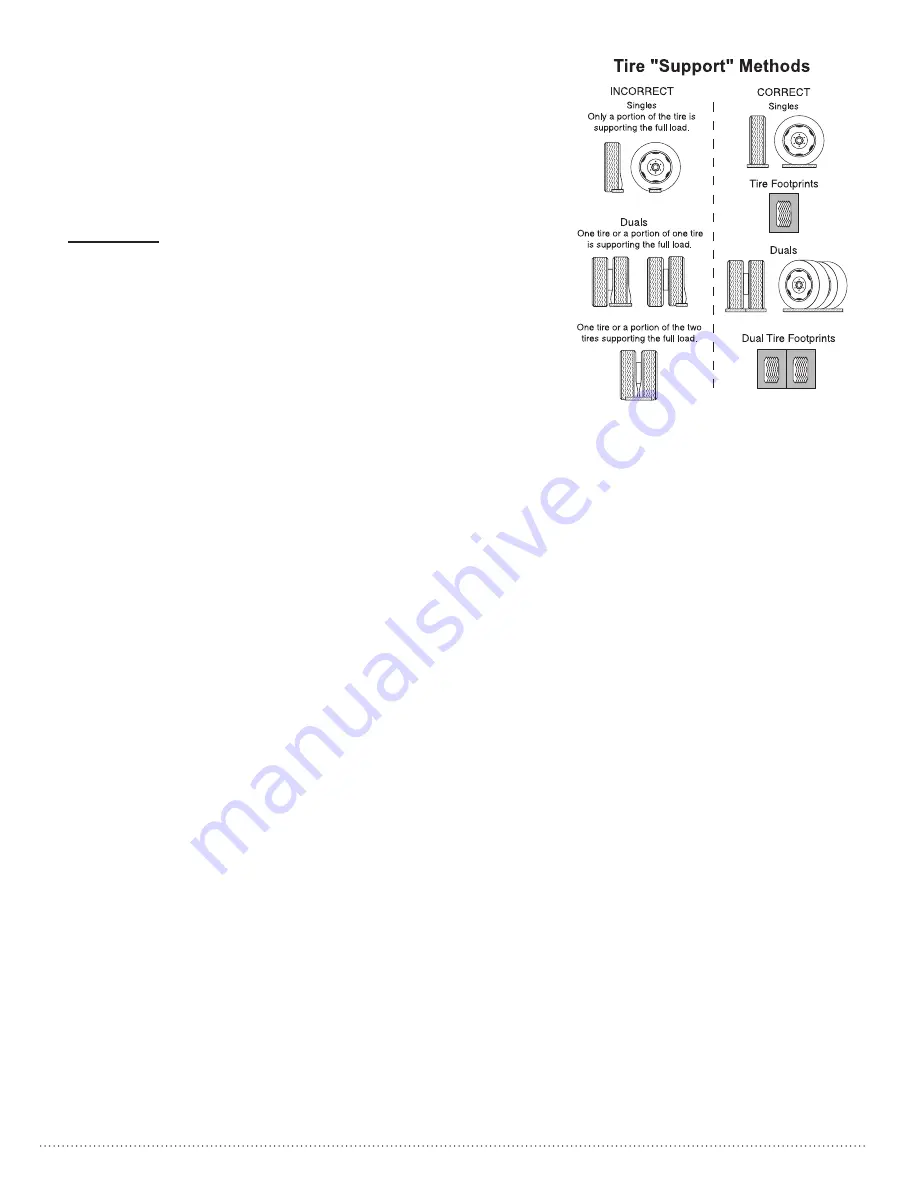
0
Supporting When Leveling
Extreme caution must be taken to ensure that the tires are fully
supported when placing blocks. The load on the tire should be evenly
distributed on the support block. In the case of dual tires, distribute the
load evenly on blocks for both tires. If not properly supported, the steel
cables in the sidewall of the tires may be damaged and could lead to
premature fatigue of the sidewall.
CAUTION:
Supporting the tires prevents damage to the sidewall of the tires
and does not prevent tire roll.
Tire Vibration
Sudden tire failure or blowout is often preceded by tire vibration.
Some other symptoms that can cause tire failure are a bulge in the
sidewall or swelling in the tire body. Striking an object or large hole in
the road surface can damage a tire. Inspect the tires immediately after
such an occurrence. Continue to inspect the tires periodically thereafter
in case minor damage occurred. Rotation forces can continue to stress damaged areas that can manifest later in a
sudden tire failure. If an unusual vibration begins, or a bulge is noticed in a sidewall, have the tires evaluated by a
qualified professional as soon as possible.
Tire Rotation
Tire rotation can increase the useful life of the tires by achieving uniform wear on all of the tires. The first tire
rotation is the most important in determining which rotation pattern to use. Have the tire manufacturer determine
the tire rotation pattern. Any unusual or unique wear patterns, or indications of uneven wear that may have
developed, should be evaluated for possible tire rotation. Misalignment, imbalance or other mechanical problems
may exist and will need to be corrected prior to rotation. After a tire rotation, check and adjust the inflation
pressures for the actual loads of the wheel position accordingly. Tires are warranted by the tire manufacturer. The
motorhome manufacturer is not responsible for warranty coverage or tire wear.
Tire Replacement and Related Information
As represented within the tire manufacturer’s published tire data guide, the size and rated load carrying capacity
of the original equipment tires on your motorhome meet or exceed the motorhome’s maximum axle weight/load
ratings. Criteria used to determine when tire replacement is necessary are road hazard damage, wear, and age.
Tire replacement based on wear is determined by either measuring the tire’s groove depth or a visual inspection
of wear bars. Replace tires when the groove depth is 2/32" or less on rear tires and 4/32" or less on front tires.
Wear bars are raised areas cast into the groove of the tire. Replace the tire when the wear bar in the groove is even
(preferably before) with the road surface contact patch. A worn out tire cannot adequately channel water through
the groove, which will result in hydroplaning.
The tire manufacturer determines tire replacement based on age. While ozone inhibitors in the rubber help
extend the life expectancy of a tire, exposure to the elements slowly breaks down the rubber, which can then
suddenly fail when put to use. Tires that are five to seven years old (depending upon environment) are considered
age worn and need to be replaced for safety even though the tire may not outwardly show age weathering and
still has considerable tread. Replacement tires must be of the same manufacturer brand, model, size, and load
range at each wheel position (matched set) and must have a load rated carrying capacity equal to or greater than
the original equipment tires. Mixing tires of a different brand, model, size, load rating and load range can cause
unusual handling and uneven braking due to different traction coefficient and could result in sudden tire failure or
loss of control due to non-symmetrical handling.
020063b modified




































